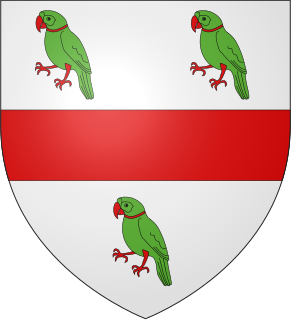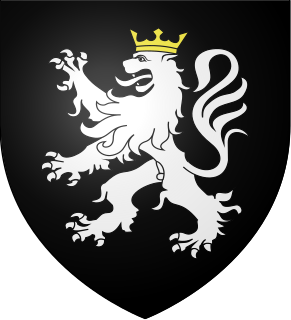
The Battle of Stirling Bridge was a battle of the First War of Scottish Independence. On 11 September 1297, the forces of Andrew Moray and William Wallace defeated the combined English forces of John de Warenne, 6th Earl of Surrey, and Hugh de Cressingham near Stirling, on the River Forth.

Stirling Castle, located in Stirling, is one of the largest and most important castles in Scotland, both historically and architecturally. The castle sits atop Castle Hill, an intrusive crag, which forms part of the Stirling Sill geological formation. It is surrounded on three sides by steep cliffs, giving it a strong defensive position. Its strategic location, guarding what was, until the 1890s, the farthest downstream crossing of the River Forth, has made it an important fortification in the region from the earliest times.
There have been at least eight sieges of Stirling Castle, a strategically important fortification in Stirling, Scotland. Stirling is located at the crossing of the River Forth, making it a key location for access to the north of Scotland.
Andrew Moray, also known as Andrew de Moray, Andrew of Moray, or Andrew Murray, was an esquire, who became one of Scotland's war-leaders during the First Scottish War of Independence. He initially raised a small band of supporters at Avoch Castle in early summer 1297 to fight King Edward I of England, and soon had successfully regained control of north Scotland for the Scots king, John Balliol. He subsequently merged his army with that of William Wallace, and jointly led the combined army to victory at the Battle of Stirling Bridge on 11 September 1297. Moray was mortally wounded in the fighting at Stirling, dying at an unknown date and place that year.

Bothwell Castle is a large medieval castle, sited on a high, steep bank, above a bend in the River Clyde in South Lanarkshire, Scotland. It is located between Bothwell and Uddingston, about 10 miles (16 km) south-east of Glasgow. Construction of the castle was begun in the 13th century by the ancestors of Clan Murray, to guard a strategic crossing point of the Clyde. Bothwell played a key role in Scotland's Wars of Independence, changing hands several times.

Urquhart Castle is a ruined castle that sits beside Loch Ness in the Highlands of Scotland. The castle is on the A82 road, 21 kilometres (13 mi) south-west of Inverness and 2 kilometres (1.2 mi) east of the village of Drumnadrochit.

The First War of Scottish Independence was the first of a series of wars between English and Scottish forces. It lasted from the English invasion of Scotland in 1296 until the de jure restoration of Scottish independence with the Treaty of Edinburgh–Northampton in 1328. De facto independence was established in 1314 at the Battle of Bannockburn. The wars were caused by English kings attempting to establish their authority over Scotland while Scots fought to keep English rule and authority out of Scotland.
George Gordon, 5th Earl of Huntly, was Lord Chancellor of Scotland and major conspirator of his time.

Dumbarton Castle has the longest recorded history of any stronghold in Scotland. It sits on a volcanic plug of basalt known as Dumbarton Rock which is 240 feet (73 m) high and overlooks the Scottish town of Dumbarton.
Gartnait of Mar, Earl of Mar – Gartnait mac Domhnall, 8th Mormaer of Mar, was a Scottish noble during the first War of Scottish Independence (1296–1328). His name is sometimes rendered as Gartney or Gratney. A son of Domhnall I, Earl of Mar, and his wife, Elen ferch Llywelyn, Gartnait of Mar died in about 1305.
John of Argyll, was a Scottish nobleman of the early 14th century. He is often known to today as John Bacach, "the Lame", but there is no authority for that as a contemporary or near-contemporary nickname.

Sir Marmaduke Thweng, later 1st Baron Thweng, was an English knight from Yorkshire who fought in the Wars of Scottish Independence.

John Segrave, 2nd Baron Segrave was an English commander in the First War of Scottish Independence.
Dundee Castle was a castle in Dundee, Scotland, destroyed by Robert the Bruce in 1313.
Alexander Pilche was a 13th-century Scottish burgess. He joined with Andrew de Moray during the 1297 uprising in northern Scotland against the administration and overlordship of King Edward I of England. He was the Governor of Inverness Castle on behalf of the English in 1304. before being replaced in 1305 and joining King Robert I of Scotland's campaign in Moray in 1307. As a reward he was appointed Sheriff of Inverness until his death.

Sir Andrew de Rait of Rait was a 13th-14th century Scottish noble. Andrew de Rait was the younger brother of Gervase de Rait, Constable of Invernairn. Andrew was Constable of Nairn Castle in 1296. He appears on the 1296 Ragman Roll giving homage to King Edward I of England. He succeeded to his brother's estates and titles in 1297.

Sir William de Monte Alto of Ferne, also known as William de Mohaut (d.1327) was a 13th-14th century Scottish noble.
The English invasion of Scotland of 1298 was a military campaign undertaken by Edward I of England in retaliation to a Scottish uprising in 1297, the defeat of an English army at the Battle of Stirling Bridge and Scottish raids into Northern England.

Sir Henry St Clair was a 13th-14th century Scottish noble, who was the 7th Baron of Roslin and Lord of Catcune.
The English invasion of Scotland of 1296 was a military campaign undertaken by Edward I of England in retaliation to the Scottish treaty with France and the renouncing of fealty of John, King of Scotland and Scottish raids into Northern England.











